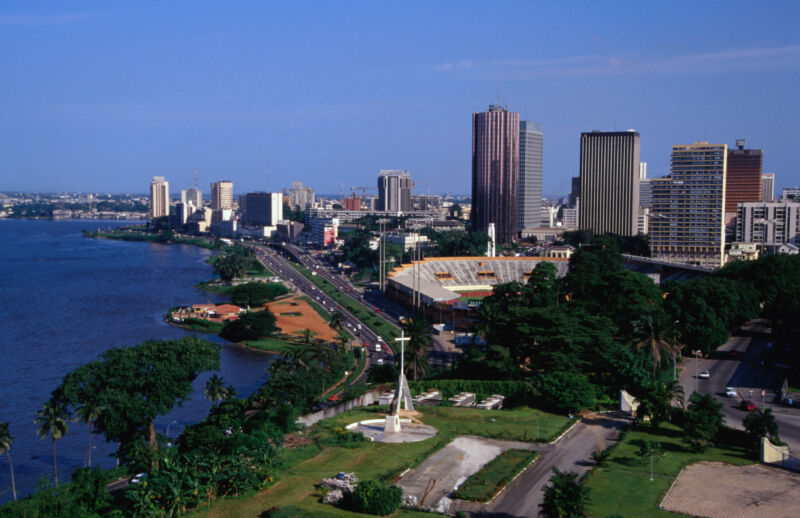Fiber fiasco —
Parts of Africa were already seeing web disruptions from damaged Red Sea cables.
Scharon Harding
– Mar 15, 2024 10:40 pm UTC

Enlarge / View of Le Plateau and Ebrie Lagoon from the top of the Cathedrale St-Paul in Côte d’Ivoire (Ivory Coast), one of the affected countries.
Thirteen countries across Africa experienced Internet outages on Thursday due to damage to submarine fiber optic cables. Some countries, including Ghana and Nigeria, are still suffering from nationwide outages.
Multiple network providers reported Internet outages yesterday, and Cloudflare’s Radar tool, which monitors Internet usage patterns, detailed how the outage seemingly moved from the northern part of West Africa to South Africa. All 13 countries (Benin, Burkina Faso, Cameroon, Côte d’Ivoire, Ghana, Guinea, Liberia, Namibia, Niger, Nigeria, South Africa, The Gambia, and Togo) reportedly suffered nationwide outages, with most seeing multiple networks hit.
Some countries’ Internet disruptions were short-lived, such as in Gambia and Guinea, as they lasted for 30 minutes, per Cloudflare. Other outages, like in South Africa (five hours) were longer, and some remain ongoing. As of this writing, Cloudflare reports that six countries, including Benin, Burkina Faso, Cameroon, and Côte d’Ivoire, are still suffering outages.
The outages started at around 05:00 UTC on Thursday in Guinea, Liberia, and The Gambia, Cloudflare said in a blog post that also shares charts of the affected countries’ Internet usage. South of those countries, Côte d’Ivoire saw disruptions begin at 07:30 UTC that day, per Cloudflare’s data. Inland, at 16:31 UTC, problems reached Niger in Central Africa.
Numerous sources, including local network providers, like Vodacom, MTN, and the Nigerian Communications Commission, reported that damage to multiple undersea cables is to blame. A Thursday press release from Reuben Muoka, director of public affairs at NCC, said: “The cuts occurred somewhere in Cote de’Ivoire and Senegal, with an attendant disruption in Portugal.”
In an Azure status report, Microsoft said it “determined” that “multiple cables” on the West African coast, including Africa Coast to Europe, MainOne, SAT3, and West Africa Cable System, were disrupted. You can see a map of the cables that were damaged here. The source of the cable damage is undetermined.
“In addition to these cable impacts, the ongoing cable cuts in the Red Sea—EIG, Seacom, AAE-1 — are also impacting overall capacity on the East Coast of Africa. These incidents together had reduced the total network capacity for most of Africa’s regions,” Microsoft said.
Earlier this month, three undersea fiber cables in the Red Sea were cut, disrupting an estimated 25 percent of Internet traffic in the Middle East, Asia, and Europe and forcing plans to reroute traffic. The cause of these damaged cables hasn’t been confirmed.
Undersea cable-related Internet outages aren’t new, as such cables are responsible for an estimated 99 percent of intercontinental traffic, per calculations by TeleGeography citing data from Euroconsult (TeleGeography notes that minimal data means its calculations aren’t “precise”) and can last a while. Much of Tonga, for example, had to rely on satellite dishes for Internet access in 2019 for 12 days due to a submarine fiber cable.
>>> Read full article>>>
Copyright for syndicated content belongs to the linked Source : Ars Technica – https://arstechnica.com/?p=2010677































